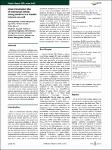Cross-transmission rates of enterococcal isolates among newborns in a neonatal intensive care unit
Böhme, Henning
Königsmark, Chitra
Klare, Ingo
Zischka, Melanie
Werner, Guido
Enterococci are important pathogens causing nosocomial infections and patients at risk include also premature babies requiring intensive care treatment. Our aim was to assess occurrence and cross transmission rates of enterococci among neonatal patients of a hospital ward during a two months period. Rectal and skin samples were taken between day one and 60 of infants’ age. Colonization with various potentially pathogenic bacteria was correlated with developing a subsequent infection. Enterococcal isolates were identified by colony morphology. The bacterial species was assessed and antibiotic susceptibilities were determined. A molecular analysis of 20 investigated enterococcal isolates revealed prevalence of commensal strain types; hospitalassociated strain types or multi-resistant variants were absent. Cross transmission of E. faecium and E. faecalis isolates among neonatal patients attending the intensive crare unit at the same time was demonstrable. Introduction of hospital-associated, multi-resistant variants into this special setting has to be avoided to reduce the risk of subsequent infections.
No license information

